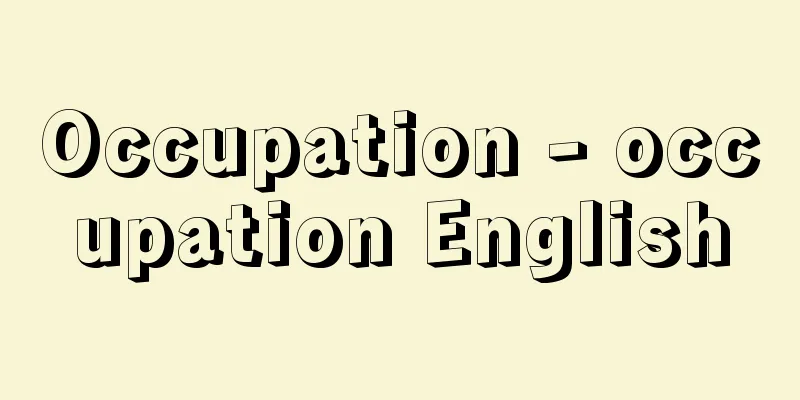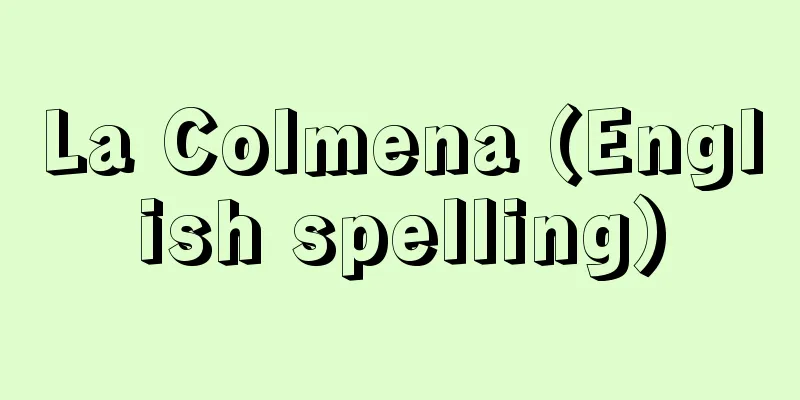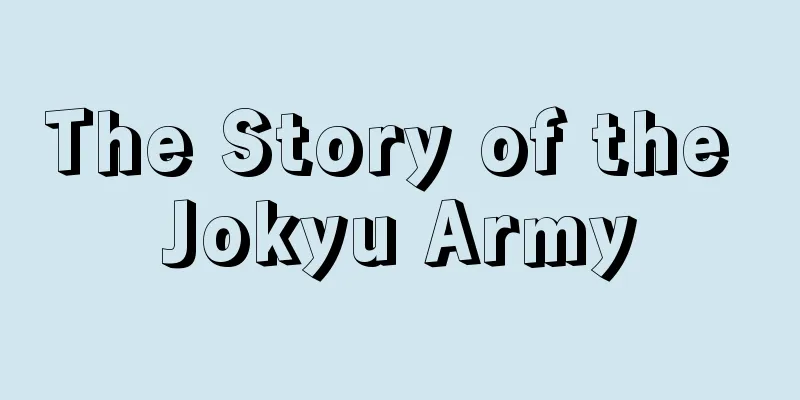Occupation - occupation English

|
It is a continuous mode of activity in which people who live in a society where the division of social labor is established take on a social role according to their talents and circumstances, and while continually carrying out and realizing this role, they receive a certain amount of income in return and acquire the necessary living materials. In addition to occupation, there are other expressions such as profession, trade, vocation, and calling in English. [Akira Hamashima] The concept of occupation and its problemsTo put it more simply, an occupation is nothing other than "a continuous pattern of human behavior aimed at expressing individuality, realizing solidarity, and maintaining a livelihood" (Kunio Odaka). This definition of the concept includes the personal, social, and economic aspects of occupation. (1) The expression of individuality as a personal aspect means, on the premise that one selects a profession according to one's abilities, capabilities, and talents, and by dedicating oneself to the demands of that profession, one develops one's individuality, achieves personal growth, and experiences self-realization, a sense of fulfillment, and a sense of purpose in life, or the possibility of doing so. However, in reality, occupational activities are not necessarily allocated according to aptitude, and as a result of technological progress and the enlargement and complexity of production systems, there is a trend toward segmentation and fragmentation, and toward alienation, so that, although the degree of this varies depending on the profession, it is generally difficult today to express one's individuality and to realize one's self. (2) The realization of solidarity in the social aspect means that, by taking part in the division of social labor and fulfilling the required role, regardless of whether it is subjective or intentional, objectively and ultimately, a relationship of mutual dependence is established among an unspecified number of anonymous people, contributing to the maintenance and survival of society. This cannot be denied, but it is also true that, as Durkheim and other theorists of the division of social labor claim, occupational activities are unable to realize social solidarity in a pre-established manner, and at the same time cause divisive situations such as class differentiation and class conflict. (3) Needless to say, the economic aspect of maintaining a living is the minimum condition for a job, and today, whether one likes it or not, most people engage in occupational activities as a means to obtain food and clothing. The more labor is alienated and occupational activities are deprived of spiritual content, the more people tend to focus on material rewards and not devote themselves to their work, and occupations tend to be viewed as a "necessary evil" that people are forced to engage in in order to make a living. Regardless, occupational activities are an end in themselves, like play or hobbies, and are not self-contained, immediate expressive activities that allow one to enjoy the process and experience freedom, self-realization, or a sense of purpose in life. If one becomes a master or expert in a field, his or her work can reach the level of play, but for the average person, the work is merely a means to an end, and one does not move beyond a mode of behavior in which one gives up direct satisfaction of desires, expression of individuality, or self-realization in preparation for future events, and resignedly accepts the coercion imposed by the occupation. Thus, instrumental activities for the purpose of making a living fall into serious contradiction with expressive activities such as expressing one's individuality and self-actualization, and tend to run counter to public interest in realizing social solidarity. This is where the gap and conflict between the ideal and reality of work comes into play, and this is what gives shape to the problems surrounding modern occupations. [Akira Hamashima] Occupation FunctionsThe above-mentioned three functions - expressing individuality (self-realization), realizing solidarity, and maintaining a livelihood - correspond to the personal, social, and economic functions of an occupation, and while each function has positive and negative aspects, they interrelate to make an occupation a dynamic unity. (1) The most concrete and direct of these is maintaining one's livelihood through the acquisition of material rewards, and in that respect, one's occupation is considered a livelihood (nariwai/sugiwai) and is the subject of greatest concern. In fact, the amount of income determines one's standard of living and lifestyle, and greatly influences one's happiness or unhappiness in life. (2) However, of course, happiness or unhappiness in life cannot be guaranteed by material income alone. Unless a person's occupation has meaning and he or she feels some sense of purpose and fulfillment in his or her work, he or she cannot live a fulfilling life. Expressing one's individuality and self-actualization are the spiritual rewards that such occupational activities bring. (3) Furthermore, humans are social animals and live in a relationship of mutual give and take, both materially and mentally, but sharing and carrying out professional roles means contributing to society and others, and through that, being connected to society, being accepted by others, and being valued accordingly. Social rewards in the sense of gaining social status and respect, while involving both the giving and taking of value, determine the state of humans as social animals (including satisfaction/dissatisfaction, happiness/unhappiness). (4) In relation to this, depending on the level of these mental, material and social rewards, an occupation determines the level of a person's self-esteem and sense of self, and satisfies, to some extent, the desire to belong to society. This is because an occupation mediates and connects the individual and society through the division of roles, and provides the individual with a path to society. A person who is connected to and accepted by society is exempt from or alleviates the anxiety and tension that accompanies isolation and loneliness, and can establish his or her identity through the satisfaction of the desire to belong. Of the above-mentioned spiritual rewards (expressing individuality and self-actualization), material rewards (maintaining a living), and social rewards (satisfaction of the need to belong in return for realizing solidarity), which one gives priority varies considerably from person to person and occupation. There are occupations that have all three of these (or don't have all three): high income, fulfillment, and prestige, occupations that pay a lot but are not fulfilling, and occupations that give fame and respect but pay little, so it is not possible to generalize. Also, depending on a person's way of being, circumstances, outlook on life, values, etc., there is no consistency in which of income, fulfillment, or prestige people will choose. There is a tendency for people who are struggling to make ends meet to prioritize material rewards, people who have a comfortable life to prioritize social or spiritual rewards, and people who have no worldly interests to prioritize spiritual rewards. In any case, the function of occupation is not limited to material or economical. Even people who can live without working engage in occupation because work itself determines the structure of human life, determines the rhythm of life, and disciplines life, thereby enabling a human life and mental activity. Even if it is done out of inertia or compulsion, occupational activity has positive functions such as maintaining mental and physical health, sometimes providing the joy of creativity and dedication, enabling social connections and mental exchange with others, cultivating self-esteem, and providing proof of existence. Negative reasons that make people engage in occupation include boredom due to having too much time to do, a sense of loss of goals, a sense of isolation and alienation from social connections, and a sense of deprivation and loss of self-esteem due to being socially useless. The above is clear when we look at the situation of the unemployed and retired who are excluded from occupational activities. [Akira Hamashima] Changes in occupations and views of occupationsThe differentiation of occupations is in line with the development of the division of labor in society. In primitive and ancient societies, too, priests, sorcerers, fortune tellers, singers, and other people who were mainly in charge of religious events, as well as political and military ruling classes such as chiefs and warriors, were separated from the general public and engaged in spiritual occupations, while the majority of people were engaged in physical occupations such as farming, animal husbandry, and handicrafts. However, in the underdeveloped stage of the division of labor, there was little inherent differentiation of occupations, and occupations were established only after the collapse of the self-sufficient and closed domestic economy, when previously undifferentiated work gradually became specialized and people began to exchange the results of their work with each other. This was after the so-called urban economy stage, when with the increase in population, the development of transportation, and some advances in technology, the types of specialized work gradually increased, and commerce and handicrafts separated from primitive industries, and even within these commerce and industries, specialization began to be seen according to the type of product and production process. Guilds of fellow craftsmen were formed in urban areas, and they strictly controlled the production process, quality, specifications, price, range of customers, etc. However, because occupations were hereditary and there was no freedom of choice, and emphasis was placed on protecting occupational privileges, the development of the profession beyond a certain level was prevented. Then, with the Industrial Revolution, handicrafts developed into factory-based handicrafts and then into factory-based industries, and the technical division of labor (division of labor within the business) developed further, and tasks were subdivided into technical categories. This was driven by the mechanization of tasks and the expansion of business operations, and as a result, tasks lost their overall unity and spiritual meaning, became more monotonous and fragmented, and human alienation became more severe. Taylor's scientific management and Ford's conveyor belt system represented the height of mechanization, and humans became nothing more than cogs in the machine. However, as automation progressed, signs of change also appeared in occupational labor, and scientific knowledge and the ability to make judgments based on it, as well as the ability to see the entire production process, became required. There was some optimism about the change from slaves to masters of machines, but it is debatable whether the automation of factories and offices promises a rosy future. With these changes in professional life, that is, from the finished product that characterized the handicraft stage to the mechanized factory industry characterized by the development of technical division of labor through mechanization, and further to the stage of automation, the view of occupations also changed significantly. In ancient society, mental labor was the work of the rulers and physical labor was the work of the ruled (slaves), so physical labor was considered lowly and a necessary evil of the material. In the Middle Ages, profit-making activities were rejected by Christianity, but work in monasteries was made mandatory to a minimum extent in order to maintain their economic foundations. During the later Reformation, Luther preached the necessity of work against laziness, and Calvin advocated worldly asceticism and attempted to combine religious ethics and professional ethics. Here, occupations were given a positive meaning as a vocation or calling. During the Renaissance, professional work was positively evaluated as an inherently creative activity (Leonardo da Vinci). This view of professional work was carried over to the craftsmanship under the perfection production system, which highly valued absorption and fulfillment in one's work, pride in one's occupation, inner identification with one's work and products, autonomy, spontaneity, and self-realization in the workplace. However, with the progress of rationalization, mechanization, and division of labor after the Industrial Revolution, the ideal image of professional work as represented by the craftsman spirit has been completely dismantled, and the occupational crisis has become more serious, with the loss of professional autonomy due to the shift from self-employment to employment, the collapse of professional honor due to the breakdown of work into monotonous partial tasks, and a lack of interest in alienated work, which continues to this day. It is said that the main interest of modern workers in life is no longer in professional work itself, but is largely inclined toward leisure and play. It is still unclear what changes automation will bring to professional work, but the urgent issue is how to overcome or alleviate the labor alienation caused by advanced technological devices and huge organizations. Attempts to humanize work, such as job enrichment and job expansion, and movements toward management participation and self-management, are attracting attention as measures to restore lost professional autonomy and establish human subjectivity. [Akira Hamashima] Occupation types and typologiesAs a result of the advancement of social division of labor leveraging technical division of labor (division of labor within management), occupations have diversified into an extremely diverse range, and their number is said to number in the tens of thousands. However, this wide variety of occupations can also be categorized into several occupational types. The most common method is the occupational classification used in the population census, which allows us to know what occupations make up a country's population. The first population census was conducted in Japan in 1920 (Taisho 9), but after World War II, in order to make the survey results internationally comparable, a new classification method based on the International Standard Classification of Occupations (ISCO) of the International Labor Organization (ILO) was adopted for the population census of 1950 (Showa 25). In the 1985 population census, occupations were divided into 11 major categories, 57 medium categories, and 293 minor categories. According to this, the major categories are: A. Professional and technical workers, B. Managerial workers, C. Clerical workers, D. Sales workers, E. Agriculture, forestry and fishery workers, F. Mining workers, G. Transport and communications workers, H. Skilled workers, production process workers and labor workers, I. Security workers, J. Service workers, and K. Occupations that cannot be classified. These occupational types can be more simply categorized into seven groups: professional, managerial, clerical, sales, skilled, semi-skilled, and unskilled. Of these, the first four constitute non-manual occupations, while the last three constitute manual occupations. The former are usually called white-collar and the latter blue-collar. Note that the above are classifications or typologies based on occupations, and are not the same as industrial classifications. In today's society, where occupational differentiation has progressed, it is common for various occupations to belong to the same industrial sector, and for the same types of occupations to belong to different industrial sectors. Occupations are related to the content and conditions of an individual's work, and are, so to speak, a definition of people, while industries are a definition of the business of the company or organization to which an individual belongs, or the place where the business is carried out, and are concerned with the purpose of the business and the type of products or services. Industrial classifications are a classification of the types of such business establishments. Thus, occupational classifications and industrial classifications must be conceptually distinct, but of course in practice they are closely related. Industrial classifications, along with occupational classifications, are important in understanding a country's population structure and how it has changed over time. [Akira Hamashima] Population composition and trends by occupation and industryLet us take a look at the changes in the population composition by occupation and industry. Needless to say, industries are divided into primary industries, including agriculture, forestry, and fishing, secondary industries, consisting of mining and manufacturing, and tertiary industries, consisting of commerce and services. In general, the normal course of occupational differentiation since the modern era has been from a dominance of primary industry to a dominance of secondary industry, and then to a dominance of tertiary industry. Of course, the circumstances differ from country to country, but in the stage where industry is underdeveloped, the overwhelming majority of the population is engaged in agriculture, forestry, and fishing (especially agriculture), and the commercial and industrial population is very small. A stagnant traditional society centered on agriculture is the normal form of pre-industrial society, but eventually industry separates from self-sufficient agriculture, commodity production becomes popular, farm family labor is commodified (= wage labor), the peasant class breaks up, a landslide population movement occurs, and the population concentrates in cities or industrial areas, resulting in a rapid increase in the mining and industrial population. However, as the capital structure in the industrial sector became more advanced, the growth in the number of workers gradually slowed. Instead, commercial and service industries advanced as the distribution and distribution mechanisms for goods were gradually established. On the other hand, as living standards improved and lifestyle demands diversified, there was a rapid increase in mental occupations such as professional, technical, and freelance occupations. In today's developed countries, tertiary industry workers are exceeding half of the working population. According to a 1982 survey by the Organization for Economic Cooperation and Development (OECD), in the UK and the US, primary industry is extremely low at 3-4% or less, while secondary industry is at the 20-30% level and tertiary industry is over 60%, making it clear that the industrial structure is moving toward a tertiary industry-centered structure. Germany and France are slightly behind, but a similar trend is seen. This is the arrival of a so-called post-industrial society and a society of advanced mass consumption. The same is true in Japan, where primary industry workers have dropped sharply from just over 50% to just over 10% in just a few decades, indicating the rapid disintegration of the peasant class due to the progress of industrialization and high economic growth, while the tertiary industry has grown dramatically since the 1960s and now accounts for more than half of the workforce. [Akira Hamashima] Occupations and ClassesWhat kind of changes will this transition in the industrial structure, that is, the progress towards deindustrialization, bring about in the social structure? As mentioned before, certain qualifications, educational background, and abilities are required to enter a profession, and appropriate material and social rewards are given in exchange for performing a professional role. In other words, a certain income or employment status, a prescribed standard of living and life opportunities, and the corresponding social status or discriminatory social evaluation (ranking of prestige) are the basis for sorting people into one class or another. It is said that there is no distinction between high and low, or noble and lowly, but regardless of the ideal, in reality today, occupation has become an important factor in determining class, replacing wealth and family status. According to several surveys on the social evaluation (ranking) of occupational types, in every country, professionals and managers are highly rated and form the upper stratum, clerical and sales (and some skilled) are placed in the middle stratum, and semi-skilled and unskilled workers are generally ranked in the lower stratum. This ranking is based on highly specialized knowledge and skills and a high level of responsibility for the public welfare, and if a position is functionally important and has rare value, it is ranked at the highest level. In contrast, unskilled, low-paid, dangerous and dirty occupations are considered the least desirable occupations and tend to be rated at the bottom. Also, the ranking order (prestige hierarchy) is almost the same in each country because the industrial structures are similar and the discriminatory evaluation of people also has common aspects. In the case of Japan, the industrial structure changed drastically during the postwar high economic growth, and the class structure also changed significantly. One of these was the rapid decline (disintegration) of the farming class, which played a part in the old middle class, and the increase in clerical and sales-related occupations, which indicates that the farming class moved out to become employed workers. At the same time, it is noteworthy that the number of people in clerical and sales jobs, including a large proportion of professional and managerial jobs (called white-collar or new middle class), significantly exceeded the number of workers (blue-collar). This tendency for the new middle class to expand is a phenomenon commonly observed (at least on the surface) in the class structures of advanced industrial countries, and is a strong reason to deny the tendency of proletarianization in the sense that the highly industrialized society of today will be polarized into the capitalist class and the working class. This seems to indicate a transformation in the class structure that corresponds to the arrival of the post-industrial society that D. Bell describes. According to him, in a post-industrial society, theoretical and technical knowledge will assume a central role, and the dominance of the professional and technical class that carries it (and therefore the rule of the technocrats) will become unshakable. The arrival of technocracy cannot be explained solely by the transition of industrial and occupational structures, but the direction of change in the class structure seems to indicate such a trend on the surface. [Akira Hamashima] "New Drafts on the Sociology of Occupation, I and II, by Odaka Kunio (1953, Fukumura Shoten)" ▽ "Lectures on Industrial Sociology, by Odaka Kunio (1981, Iwanami Shoten)" ▽ "Sociology of Occupational Life, edited by Iwanai Ryoichi (1975, Gakubunsha)" ▽ "The Division of Labor in Society, by E. Durkheim, translated by Tahara Otowa (1971, Aoki Shoten)" ▽ "The Coming of Post-Industrial Society, Volumes 1 and 2, by D. Bell, translated by Uchida Tadao et al. (1975, Diamond Publishing)" [References] | | | | |Source: Shogakukan Encyclopedia Nipponica About Encyclopedia Nipponica Information | Legend |
|
社会的分業の成立している社会において生活を営む人々が、それにつくことによって、その才能と境遇に応じた社会的役割を分担し、これを継続的に遂行し実現していくかたわら、その代償として一定の収入を取得し、必要な生活資料を獲得する継続的活動様式をいう。なお、英語ではオキュペーションのほかに、プロフェッションprofession、トレードtrade、ボケーションvocation、コーリングcallingなどの表現がある。 [濱嶋 朗] 職業の概念と問題点前述の定義をもっと簡単にいいかえるならば、職業とは「個性の発揮、連帯の実現および生計の維持を目ざす人間の継続的な行為様式」(尾高邦雄(くにお))にほかならない。この概念規定には職業のもつ個人的、社会的、経済的諸側面が含まれている。 (1)個人的な側面としての個性発揮は、自己の能力・性能・才能に応じた職業を選択するという前提のもとで、その職業が課する要求にこたえて献身するなかで、自己の個性を伸張し、人間的成長を遂げ、自己実現とやりがい、生きがいを経験すること、またはその可能性を意味する。ただ、現実の職業活動はかならずしも適性に応じて配分されておらず、また技術が進歩し、生産の仕組みが巨大化し複雑化した結果、細分化と断片化を受け、疎外されざるをえない趨勢(すうせい)にあるので、職業によって程度の差はあるが、個性発揮や自己実現は今日概して困難な状態にある。 (2)社会的な側面としての連帯実現は、社会的分業の一端を担い、その要求する役割を遂行することを通じて、主観的、意図的にはともかく、客観的、結果的には匿名の不特定多数の人々の間に相互依存の関係を成立させ、社会の維持・存続に貢献することになるという事態を意味する。このことは否定できないが、デュルケームをはじめとする社会分業論者の主張するようには、職業活動は予定調和的に社会連帯を実現できずに、階級分化や階級対立などの分裂的事態を同時に引き起こしているのも事実である。 (3)経済的な側面としての生計維持は、いうまでもなく職業の最低限の条件であり、今日ほとんどの人々は好むと好まないとにかかわらず、衣食の資を得るための手段として職業活動に携わっている。労働が疎外されて職業活動から精神的内容が奪われれば奪われるほど、人々の関心は物質的な報酬に集中し、仕事に没頭しなくなる傾向があり、職業は生活のためにやむなく従事する「必要悪」とみなされやすい。それはともかく、職業活動は、遊びや趣味のようにそれ自体が目的であって、その過程を享受して自由とか、自己実現あるいは生きがいを味わうといった自己完結的、即時達成的な表出的活動ではない。その道の巨匠や名人ほどの人になれば、その仕事は遊びの境地に達しうるが、凡人の仕事はあくまでも手段的活動であり、将来の事態に備えて欲求の直接的充足や個性の発揮ないしは自己実現を断念し、職業の課する強制を甘んじて受け入れる行為様式を出るものではない。こうして、生計維持のための手段的活動は、個性発揮、自己実現といった表出的活動と深刻な矛盾に陥り、また社会連帯の実現への公的な関心と背馳(はいち)する方向に働きやすい。そこに職業をめぐる理念と現実のギャップと葛藤(かっとう)があり、またそれが現代の職業をめぐる問題点を形づくっている。 [濱嶋 朗] 職業の機能以上にみた個性発揮(自己実現)、連帯実現、生計維持は、それぞれ職業の個人的・社会的・経済的機能にあたり、それぞれの機能はプラスの側面とマイナスの側面を伴いながら、相互に関連して動的な統一としての職業を成り立たせる。 (1)そのうち、もっとも具体的、直接的なのは物質的報酬の獲得による生計維持であり、その点で職業は生業(なりわい/すぎわい)とみなされ、最大の関心事となる。実際、収入の多い少ないは、その人の生活程度、生活様式を決め、人生の幸・不幸を大きく左右する。 (2)しかしもちろん、人生の幸・不幸は物質的な収入だけでは保証できない。人が携わる職業が意味をもち、多少とも仕事に生きがい、やりがいを感じるのでなければ、その人は充実した生活を送れない。個性発揮、自己実現とはそうした職業活動のもたらす精神的報酬である。 (3)さらに、人間は社会的動物であり、物質的にも精神的にも相互にギブ・アンド・テイクの関係にたちつつ生活しているが、職業的役割を分担し、それを遂行することは、社会や他者に貢献し、それを通じて自分も社会につなげられ、他から受け入れられ、それなりに評価されるということを意味する。社会的な地位とか尊敬の獲得という意味での社会的報酬は、価値付与と価値剥奪(はくだつ)の両面を伴いながら、社会的動物としての人間のあり方(満・不満、幸・不幸を含め)を規定することになる。 (4)また、これと関連して、職業はこれらの精神的・物質的・社会的報酬のいかんに応じて、人間の自尊心、自我感情の高下・強弱を規定するとともに、社会への帰属欲求を多少なりとも満足させる。それは、職業が役割分担を通じて個人と社会とを媒介し連結し、個人に社会への通路を提供するからでもある。社会に連結され受容された人間は、孤立と孤独に伴う不安と緊張を免除ないし緩和され、帰属欲求の充足を通じてアイデンティティを確立しうる。 以上にあげた精神的報酬(個性発揮・自己実現)、物質的報酬(生計維持)、社会的報酬(連帯実現の見返りとしての帰属欲求などの充足)のうち、どれを優先させるかは、職業により人間によってかなり相違してくる。高収入、やりがい、名声の三拍子そろった(あるいはそろわない)職業もあれば、収入は多いがやりがいのない職業、名声や尊敬は与えられるが収入は少ない職業などさまざまであって、一概には論じられない。また、人間のあり方、境遇や人生観、価値観などによっても、収入、やりがい、名声のどれを選ぶかは一定していない。生活に追われる人は物質的報酬を、生活にゆとりのある人は社会的または精神的報酬を、世俗的な関心のない人は精神的報酬を優先させるなどといった傾向があるにはあるが。 いずれにせよ、職業の機能は、単に物質的、経済的なものに限定されない。働かなくても生活できる境遇の人でも職業に携わるのは、仕事自体が人間の生活構造を規定し、生活のリズムを決め、生活を規律づける作用を営むことによって、人間らしい生活と精神活動を可能にするからである。たとえ惰性的、強制的なものであっても、職業活動は心身の健康を保持し、ときに創造や献身の喜びを与え、他者との社会的関連、精神的交流を可能にし、自尊心を培い、存在証明を付与するなどの積極的な機能を営む。また、人々を職業に携わらせる消極的な理由としては、あり余る時間をもてあます退屈感、目標喪失感、社会的関連からの孤立感・疎外感、社会的に役だっていないという価値剥奪感・自尊心の喪失などがあげられる。以上のことは、職業活動から排除された失業者や退職者の置かれた状況をみれば明らかであろう。 [濱嶋 朗] 職業および職業観の変遷職業の分化は社会的分業の展開と軌を一にしている。未開社会や古代社会にも僧侶(そうりょ)、呪術(じゅじゅつ)師、占い師、歌い手などおもに宗教的行事をつかさどる人々や、首長(しゅちょう)、戦士などの政治的・軍事的支配層が一般の人々から遊離して精神的職業に携わり、他の大多数の人々は農耕、牧畜、手工業などの肉体的職業に従事していた。しかし、分業の未発達な段階では固有の意味での職業分化に乏しく、職業が成立するのは自給自足的・封鎖的家内経済が崩壊して、これまで未分化であった仕事がしだいに専門化し、仕事の成果を互いに交換するようになってからである。これはいわゆる都市経済の段階以後のことで、人口の増加、交通の発達、技術の若干の進歩に伴い、専門的に行う仕事の種類もしだいに増大し、原始産業から商業、手工業が分離し、それらの商・工業の内部でも商品の種類や生産工程別に専門分化がみられるようになった。都市地域に同職仲間のギルドが結成され、製品の生産工程、品質、規格、価格、顧客の範囲などにわたり厳しく統制が行われた。しかし、職業は世襲であって、選択の自由はなく、職業上の特権の擁護に重点が置かれたから、職業は一定程度以上の発展を阻止された。 その後、産業革命が起こり、手工業から工場制手工業へ、さらに工場制工業へと発展するなかで、技術的分業(経営内分業)はますます発達を遂げ、作業は技術的に細分化された。これは作業の機械化や経営の大規模化によって促され、それにつれて作業はますます全体としてのまとまりや精神的意味内容を失い単調化、断片化して、人間疎外が深刻化していった。テーラーの科学的管理法やフォードのコンベヤー・システムは機械化の極致を示すもので、人間は機械の歯車にすぎなくなってきた。しかし、その後オートメーション化が進むなかで、職業労働にも若干の変化の兆しが現れ、科学的知識とそれに基づく判断能力、生産工程全体を見通す能力などが要求されるようになり、機械の奴隷から機械の主人への変化を展望する楽観論も一部にはみられたが、工場や事務所のオートメーション化がバラ色の将来を約束するかどうかは、議論の余地がある。 このような職業生活の変化、つまり、手工業段階を特徴づける完成生産から、機械化による技術的分業の進展を特色とする機械制工場工業へ、さらにはオートメーション化の段階へという推移に伴い、職業観も大きく変わってきた。古代社会では精神労働は支配者の、肉体労働は被支配者(奴隷)の仕事であったから、肉体労働は卑しく物質的な必要悪とみなされた。中世になると営利活動はキリスト教によって拒否されたが、修道院での労働はその経済的基礎を維持する必要から最小限度義務づけられた。その後の宗教改革時には、ルターは怠惰に対して勤労の必要を説き、カルバンは現世的禁欲主義を唱え、宗教倫理と職業倫理との結合を図った。ここに職業は天職または召命としての積極的な意義を与えられることになった。ルネサンス期には職業労働は本来創造的な活動として積極的に評価された(レオナルド・ダ・ビンチ)。この職業労働観は完成生産方式下の職人気質(かたぎ)に引き継がれ、仕事への没頭とやりがい、職業への誇り、仕事や生産物への内的一体化、仕事における自律性と自発性と自己実現が高く評価されることになる。 しかし、産業革命期以後の合理化、機械化、分業化の進展により、職人気質に示されたような職業労働の理想像は全面的に解体し、自営から雇用労働への移行による職業的自律性の喪失、単調な部分仕事への分解による職業的名誉の崩壊、疎外された労働への関心の欠如といった職業危機の様相が深刻化し、今日に至っている。現代の労働者の中心的生活関心はもはや職業労働そのものにではなく、余暇・遊びに大きく傾斜しているといわれる。オートメーション化が職業労働にどういう変化を引き起こすかはなお確定していないが、高度の技術装置や巨大な機構による労働疎外をいかにして克服ないしは緩和するかが緊急の課題になっている。職務充実、職務拡大といった労働の人間化への試み、経営参加や自主管理への動きなどは、失われた職業的自律性を回復し、人間の主体性を確立する方策として注目されよう。 [濱嶋 朗] 職業の種類と類型技術的分業(経営内分業)をてことする社会的分業の進展の結果、職業はきわめて多種多様に分化し、その数は数万にも上るといわれる。しかし、この多種多様な職業もいくつかの職業類型に分類することができる。そのもっとも一般的な方法は国勢調査に用いられる職業分類で、これによって一国の人口がどのような職業から構成されているかを知ることができる。わが国で第1回の国勢調査が行われたのは1920年(大正9)のことであるが、第二次世界大戦後には調査結果を国際比較ができるようにするために、50年(昭和25)の国勢調査に際して国際労働機関(ILO)の国際標準職業分類(ISCO)による新分類方式を採用した。85年の国勢調査では、大分類11項目、中分類57項目、小分類293項目に分けられている。それによると大分類は、A専門的・技術的職業従事者、B管理的職業従事者、C事務従事者、D販売従事者、E農林漁業作業者、F採掘作業者、G運輸・通信従事者、H技能工、生産工程作業者および労務作業者、I保安職業従事者、Jサービス職業従事者、K分類不能の職業、となっている。 これらの職業類型をより単純化すれば、専門、管理、事務、販売、熟練、半熟練、非熟練の7グループに便宜上分けられよう。このうち前四者は非肉体的(ノン・マニュアル)職業、後三者は肉体的(マニュアル)職業を構成し、また前者をホワイトカラー、後者をブルーカラーとよんで区別するのが普通である。 なお、以上は職業の別に基づく分類または類型であって、これと産業分類とは同じではない。職業分化が進んだ現代の社会では、同じ産業部門の内部にもいろいろな職業が属し、異なった産業部門の内部にも同じ種類の職業が属する、といったことがよくあるからである。職業はあくまでも個人の仕事の内容や条件にかかわり、いわば人間に関する規定であるが、産業はその個人が所属する会社、団体などの事業または事業の行われる場所の規定であって、事業の目的、製品またはサービスの種類が問題になる。産業分類とはそうした事業所の種類を分類したものである。このように、職業分類と産業分類は概念上は区別されなければならないが、もちろん事実上は密接な関係がある。一国の人口構成がどうなっており、どう変化してきたかを知るうえで、産業分類は職業分類とともに重要な意味をもっている。 [濱嶋 朗] 職業別・産業別人口の構成と推移そこで、職業別、産業別の人口構成がどういう変遷をたどったかを一瞥(いちべつ)しておこう。いうまでもなく、産業は農林漁業を含む第一次産業、鉱・工業(製造業)からなる第二次産業、商業・サービス業などから構成される第三次産業に分けられる。一般に、近代以後の職業分化の正常なコースは、第一次産業優位から第二次産業優位へ、さらに第三次産業優位へというコースをたどってきた。もちろん国によって事情は異なるが、産業が未発達な段階では人口の圧倒的部分は農林漁業(それも農業)に従事していて、商・工業人口はごく少ない。農業中心の停滞的な伝統的社会が産業以前の社会のごく普通の姿であるが、やがて自給自足的農業から工業が分離し、商品生産が盛んとなって、農家の家族労働力が商品化(=賃労働化)し、農民層が分解して地すべり的な人口移動がおこり、人口が都市または工業地帯に集中する結果、鉱・工業人口が急激に増大するようになる。しかし、その後工業部門では資本構成が高度化して労働者の数はしだいに伸びが鈍り、それにかわって商品の分配・流通機構がしだいに確立するなかで商業・サービス業が進出し、他方、生活水準の向上とか生活要求の多様化に伴って、専門・技術・自由業などの精神的職業が急速に増加するといった事態が進展する。 今日の先進産業諸国では第三次産業就業者が就業人口の半数を超えつつある。1982年の経済協力開発機構(OECD)調査によると、イギリスやアメリカでは第一次産業が3~4%以下ときわめて少ないのに対し、第二次産業は20~30%台、第三次産業は60%を超えており、第三次産業中心の産業構造に移行していることは明らかである。ドイツやフランスでも、これよりやや遅れるが、ほぼ同様の趨勢(すうせい)がみられる。いわゆる脱工業化社会、高度大衆消費社会の到来である。わが国についても同様であって、第一次産業就業者はわずか数十年の間に5割強から1割強へと急激に減少し、工業化の進展、高度経済成長による農民層の激しい分解を物語る反面、第三次産業は1960年代以降飛躍的に増大し、半数を上回るまでになっている。 [濱嶋 朗] 職業と階層このような産業構造の推移、つまり脱工業化へ向かっての前進は、社会構造にどういう変化を引き起こすのであろうか。前にも触れたように、職業につくには一定の資格、学歴、能力が必要であり、職業的役割の遂行と引き換えに相応の物質的・社会的報酬が与えられる。つまり、一定の所得や従業上の地位、それに規定された生活水準や生活機会、それに対応する社会的地位の付与または差別的な社会的評価(威信の格づけ)が人々をいずれかの階層に振るい分けるもとになる。職業に上下・貴賤(きせん)の別はないといわれるが、理念のうえではともかく、現実には職業は今日、財産や家格にかわって階層を決定する重要な要因になっている。 職業類型に対する社会的評価(格づけ)を行ったいくつかの調査によると、どこの国でも専門と管理の評価が高く上層を形成し、事務と販売(および熟練の一部)は中層に位置づけられ、半熟練・非熟練の労働者はおおむね下層に格づけられている。この格づけは高度の専門知識・技能や公共の福祉に対する高度の責任性を基準にして行われており、その地位が機能的に重要であって希少価値をもつ場合に、最高位に格づけられるわけである。これに反して、非熟練で低賃金の危険で手の汚れる職業は、もっとも望ましくない職業と考えられ、最下位に評価される傾向がある。また、格づけ順位(威信ヒエラルヒー)が各国ともほぼ同様になっているのは、産業構造が似通っているためであり、人間の差別的評価がやはり共通する面をもっているためであると考えられる。 ところで、日本の場合、戦後の高度経済成長過程で産業構造は大幅に変化し、それに伴って階層構造にも著しい変化が現れた。その一つは、旧中間層の一翼を担う農民層の急速な減少(分解)と事務・販売関係の職業の増大であり、農民層が雇用労働者として転出したことを物語っている。と同時に、事務・販売およびこれに専門・管理のかなりの部分を加えた人々(ホワイトカラーまたは新中間層といわれる)が労働者層(ブルーカラー)をかなり上回ったことが注目をひく。このいわゆる新中間層の肥大化傾向は先進産業諸国の階層構造に(少なくとも表面上は)共通して認められる現象であって、現代の高度産業社会が資本家階級と労働者階級へ両極分解を遂げるという意味でのプロレタリア化傾向を否定する有力な根拠となっている。そして、このことはD・ベルのいう脱工業化社会の到来という事態に見合う階層構造の変貌(へんぼう)を物語るかのようである。彼によれば、脱工業化社会では理論的・技術的知識が中心的な意義をもち、それを担う専門的・技術的階層の優位(したがってテクノクラートの支配)が動かしがたくなると考えられている。産業構造や職業構造の推移だけからはテクノクラシーの到来を理由づけるわけにはいかないが、階層構造の変動の方向は表面上そのような趨勢を示しているといえる。 [濱嶋 朗] 『尾高邦雄著『新稿職業社会学』ⅠⅡ(1953・福村書店)』▽『尾高邦雄著『産業社会学講義』(1981・岩波書店)』▽『岩内亮一編著『職業生活の社会学』(1975・学文社)』▽『E・デュルケーム著、田原音和訳『社会分業論』(1971・青木書店)』▽『D・ベル著、内田忠夫他訳『脱工業社会の到来』上下(1975・ダイヤモンド社)』 [参照項目] | | | | |出典 小学館 日本大百科全書(ニッポニカ)日本大百科全書(ニッポニカ)について 情報 | 凡例 |
<<: Employment Security Law - Shokugyoanteiho
>>: Chloro-alkali electrolysis
Recommend
Emperor Jialong
Please see the "Nguyen Fook Ying" page....
Receipt - Receipt
...The person who pays the debt has the right to ...
Acharaka Nonsense - Acharaka Nonsense
...The term "acharaka play," which refe...
Bookplate - Zoshohyohyo (English spelling)
A label affixed to the inside of a book to indica...
Ion nitriding method - Ionchikkaho
… Recently, due to the problem of wastewater poll...
Fiction - Travel
〘noun〙① To make something that is not true appear ...
Surface treated steel sheet (English: hyomenshori kohan)
Steel sheets whose surfaces are plated or coated f...
Norimitsu Isshiki
Year of death: 2nd year of Kakei/5th year of Gench...
Refractoriness - Refractoriness
The degree of fire resistance of graphite, firecla...
Paullus, Lucius Aemilius
Aemilius Paulus, brother of the Roman statesman M....
Gennosuke Sawamura - Gennosuke Sawamura
Kabuki actor. Stage name: Kinokuniya. (1) First ge...
Achimota College
…Apart from Egypt and South Africa, there were on...
Ojima (Okinawa, Nakazato Village) - Ojima
...A village in Shimajiri District, Okinawa Prefe...
Kaitakushi Convertible Securities - Kaitakushi Convertible Securities
… [Yotaro Sakudo] [Monetary legislation in modern...
Caulerpa racemosa (English name) Caulerparacemosa
…[Mitsuo Chihara]. . . *Some of the terminology t...









